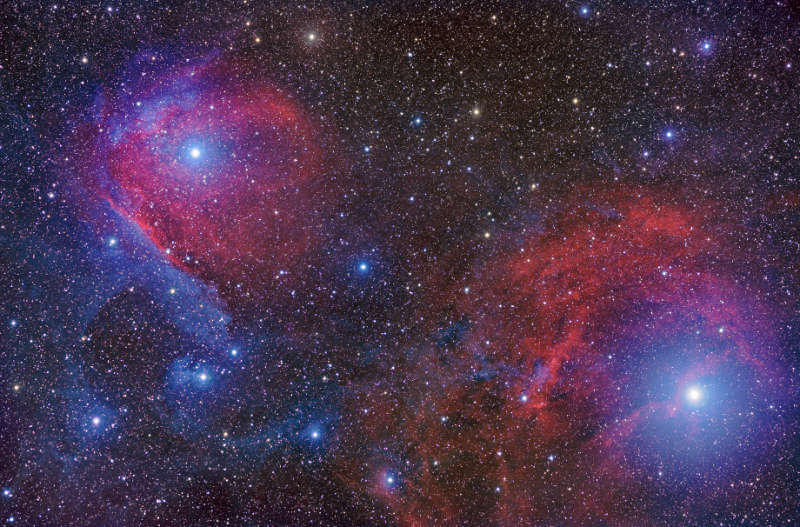Credit & Copyright: John Davis
Explanation:
Cosmic dust clouds dim the light
of background stars.
But they also reflect the light of stars nearby.
Since bright stars tend to radiate strongly in the blue portion
of the visible spectrum, and the interstellar
dust
scatters blue light more
strongly than red, the dusty reflection nebulae tend to be blue.
Lovely examples are
the wispy blue reflection nebulae near bright, hot stars
Pi and Delta
Scorpii (upper left and lower right) in this
telescopic
skyscape from the head of the constellation Scorpius.
Of course, the contrasting red emission nebulae are also
caused by the hot stars' energetic radiation.
Ultraviolet photons ionize hydrogen atoms in the interstellar clouds
producing the characteristic
red hydrogen alpha emission line
as the electrons recombine.
About 600 light-years away, the nebulae are found in the second version of
the Sharpless
Catalog as Sh2-1 (left, with reflection nebulae VdB 99) and
Sh2-7.
At that distance, this field of view is about 40 light-years
across.
1999 2000 2001 2002 2003 2004 2005 2006 2007 2008 2009 2010 2011 2012 2013 2014 2015 2016 2017 2018 2019 2020 2021 2022 2023 2024 2025 |
Yanvar' Fevral' Mart Aprel' Mai Iyun' Iyul' Avgust Sentyabr' Oktyabr' Noyabr' Dekabr' |
NASA Web Site Statements, Warnings, and Disclaimers
NASA Official: Jay Norris. Specific rights apply.
A service of: LHEA at NASA / GSFC
& Michigan Tech. U.
|
Publikacii s klyuchevymi slovami:
emission nebula - reflection nebula - nebula - otrazhatel'nye tumannosti - vodorod - pyl'
Publikacii so slovami: emission nebula - reflection nebula - nebula - otrazhatel'nye tumannosti - vodorod - pyl' | |
Sm. takzhe:
Vse publikacii na tu zhe temu >> | |
